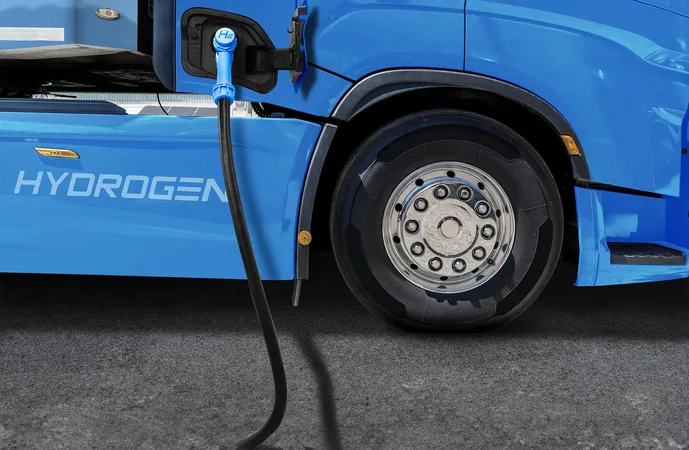
Groundbreaking UCR Research Paves the Way for Cleaner Hydrogen Engines
2024-10-09
Author: Ming
Introduction
In an age where climate change is the defining crisis of our times, hydrogen-burning internal combustion engines emerge as a promising solution—powerful, efficient, and devoid of harmful carbon emissions. These innovative engines are well-suited for heavy-duty trucks, buses, agricultural machinery, and even backup power generators, offering a cleaner alternative to traditional diesel engines. However, they come with a caveat: the emission of nitrogen oxides (NOx) during their high-temperature combustion process.
The Danger of Nitrogen Oxides
Nitrogen oxides are notorious for their role in creating harmful ozone and fine particulate matter when they react with other atmospheric compounds, posing significant risks to lung health and contributing to long-term diseases. But thanks to the pioneering work by scientists at the University of California, Riverside (UCR), there's new hope on the horizon for mitigating this pollution.
A Cost-Effective Strategy
Researchers at UCR have unveiled a cost-effective strategy to drastically cut down on NOx emissions from hydrogen engines by enhancing the efficiency of catalytic converters. In an enlightening study published in the esteemed journal *Nature Communications*, they discovered that combining platinum with a highly porous material known as Y zeolites dramatically boosts the conversion of nitrogen oxides into harmless nitrogen gases and water vapor.
Stunning Results
Tests revealed astonishing results: the catalytic converter infused with zeolites achieved a four to fivefold increase in the conversion rate of nitrogen oxides at an engine temperature of 250 degrees Celsius compared to conventional setups. This innovation is particularly vital during engine startups when temperatures are cooler and emissions tend to peak.
Broad Applications
Not limited to hydrogen engines, this technology extends its benefits to diesel engines equipped with hydrogen injection systems, primarily used in large trucks. Fudong Liu, an associate professor of chemical and environmental engineering at UCR, explained that the hydrogen injection can be integrated into current diesel systems to improve their emissions profile dramatically.
The Unique Properties of Zeolites
The zeolites harnessed in this process are notably low-cost materials with a crystalline structure made up of silicon, aluminum, and oxygen. Their unique properties, including a vast surface area and an intricate network of pores and channels, allow for optimal pollutant breakdown. By combining platinum with Y zeolite, researchers were able to create a conducive environment for hydrogen activation, a critical factor in enhancing nitrogen reduction efficiency.
A Simple Method
Lead author Shaohua Xie, a research scientist at UCR, emphasized the simplicity of this pollution reduction method. “We don’t need complex chemical processes. By merely mixing platinum with zeolite and allowing the reaction to occur, we witness substantial improvements in performance,” Liu noted.
Industry Collaborations
Collaborating with industry partners, including BASF Environmental Catalyst and Metal Solutions, the research team successfully transformed their powdered mixture into a slurry for application onto honeycomb structures within prototype catalytic converters. Insights gathered from further modeling by experts at Virginia Tech validated the conceptual framework of this innovative catalyst system.
Commercial Future
The research team is optimistic about the commercial future of this breakthrough technology, buoyed by the support of BASF, which has funded the study and is now pursuing a patent.
Conclusion
“This breakthrough is a source of pride for us,” Xie stated, “as we’ve developed a novel solution for nitrogen oxide emissions control that holds immense promise for the transportation sector and beyond.” With the automotive industry increasingly eyeing sustainable alternatives, this development could represent a significant leap towards cleaner, greener transport solutions. Are we on the brink of a hydrogen revolution that might reshape our approach to pollution and climate change? Only time will tell!



 Brasil (PT)
Brasil (PT)
 Canada (EN)
Canada (EN)
 Chile (ES)
Chile (ES)
 España (ES)
España (ES)
 France (FR)
France (FR)
 Hong Kong (EN)
Hong Kong (EN)
 Italia (IT)
Italia (IT)
 日本 (JA)
日本 (JA)
 Magyarország (HU)
Magyarország (HU)
 Norge (NO)
Norge (NO)
 Polska (PL)
Polska (PL)
 Schweiz (DE)
Schweiz (DE)
 Singapore (EN)
Singapore (EN)
 Sverige (SV)
Sverige (SV)
 Suomi (FI)
Suomi (FI)
 Türkiye (TR)
Türkiye (TR)